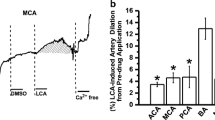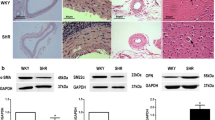Abstract
Tacrolimus (TAC, also called FK506), a common immunosuppressive drug used to prevent allograft rejection in transplant patients, is well known to alter the functions of blood vessels. In this study, we sought to determine whether chronic treatment of TAC could inhibit the activity of big-conductance Ca2+-activated K+ (BK) channels in vascular smooth muscle cells (SMCs), leading to hypertension. Our data reveal that the activity of BK channels was inhibited in cerebral artery SMCs (CASMCs) from mice after intraperitoneal injection of TAC once a day for 4 weeks. The voltage sensitivity, Ca2+ sensitivity, and open time of single BK channels were all decreased. In support, BK channel β1-, but not α-subunit protein expression was significantly decreased in cerebral arteries. In TAC-treated mice, application of norepinephrine induced stronger vasoconstriction in both cerebral and mesenteric arteries as well as a larger [Ca2+]i in CASMCs. Chronic treatment of TAC, similar to BK channel β1-subunit knockout (KO), resulted in hypertension in mice, but did not cause a further increase in blood pressure in BK channel β1-subunit KO mice. Moreover, BK channel activity in CASMCs was negatively correlated with blood pressure. Our findings provide novel evidence that TAC inhibits BK channels by reducing the channel β1-subunit expression and functions in vascular SMCs, leading to enhanced vasoconstriction and hypertension.








Similar content being viewed by others
Availability of data and material
Not applicable.
Abbreviations
- BK:
-
Big-conductance Ca2+-activated K+
- BSA:
-
Bovine serum albumin
- CA:
-
Cerebral artery
- V 1/2 :
-
Half-maximum current activation
- NPo:
-
Open probability
- τ o :
-
Open time constant
- PSS:
-
Physiological saline solution
- SMCs:
-
Smooth muscle cell
References
Akiyoshi J, Ieiri S, Nakatsuji T, Taguchi T (2009) Direct vasodilative effect of FK506 on porcine mesenteric artery in small bowel transplantation. J Pediatr Surg 44(12):2322–2326
Amberg GC, Santana LF (2003) Downregulation of the BK channel beta1 subunit in genetic hypertension. Circ Res 93(10):965–971
Amberg GC, Bonev AD, Rossow CF, Nelson MT, Santana LF (2003) Modulation of the molecular composition of large conductance, Ca(2+) activated K(+) channels in vascular smooth muscle during hypertension. J Clin Invest 112(5):717–724
Brenner R, Perez GJ, Bonev AD, Eckman DM, Kosek JC, Wiler SW, Patterson AJ, Nelson MT, Aldrich RW (2000) Vasoregulation by the beta1 subunit of the calcium-activated potassium channel. Nature 407(6806):870–876
Burnham MP, Johnson IT, Weston AH (2006) Reduced Ca2+-dependent activation of large-conductance Ca2+-activated K+ channels from arteries of type 2 diabetic Zucker diabetic fatty rats. Am J Physiol Heart Circ Physiol 290(4):H1520–H1527
Chen YF, Wang C, Zhang R, Wang H, Ma R, Jin S, Xiang JZ, Tang Q (2016) Tacrolimus inhibits vasoconstriction by increasing Ca(2+) sparks in rat aorta. J Huazhong Univ Sci Technolog Med Sci 36(1):8–13
De Lima JJ, Xue H, Coburn L, Andoh TF, McCarron DA, Bennett WM, Roullet JB (1999) Effects of FK506 in rat and human resistance arteries. Kidney Int 55(4):1518–1527
Dong L, Zheng YM, Van RD, Rathore R, Liu QH, Singer HA, Wang YX (2008) Functional and molecular evidence for impairment of calcium-activated potassium channels in type-1 diabetic cerebral artery smooth muscle cells. J Cereb Blood Flow Metab 28(2):377–386
Eichhorn B, Dobrev D (2007) Vascular large conductance calcium-activated potassium channels: functional role and therapeutic potential. Naunyn Schmiedeberg's Arch Pharmacol 376(3):145–155
Hoorn EJ, Walsh SB, McCormick JA, Fürstenberg A, Yang CL, Roeschel T, Paliege A, Howie AJ, Conley J, Bachmann S, Unwin RJ, Ellison DH (2011) The calcineurin inhibitor tacrolimus activates the renal sodium chloride cotransporter to cause hypertension. Nat Med 17(10):1304–1309
Kelly D (2011) Safety and efficacy of tacrolimus in pediatric liver recipients. Pediatr Transplant 15(1):19–24
Korde AS, Yadav VR, Zheng YM, Wang YX (2011) Primary role of mitochondrial Rieske iron-sulfur protein in hypoxic ROS production in pulmonary artery myocytes. Free Radic Biol Med 50(8):945–952
Krautz C, Wolk S, Steffen A, Knoch KP, Ceglarek U, Thiery J, Bornstein S, Saeger HD, Solimena M, Kersting S (2013) Effects of immunosuppression on alpha and beta cell renewal in transplanted mouse islets. Diabetologia 56(7):1596–1604
Liu QH, Zheng YM, Wang YX (2007) Two distinct signaling pathways for regulation of spontaneous local Ca2+ release by phospholipase C in airway smooth muscle cells. Pflugers Arch 453(4):531–541
Liu QH, Zheng YM, Korde AS, Yadav VR, Rathore R, Wess J, Wang YX (2009) Membrane depolarization causes a direct activation of G protein-coupled receptors leading to local Ca2+ release in smooth muscle. Proc Natl Acad Sci U S A 106(27):11418–11423
Liu QH, Savoia C, Wang YX, Zheng YM (2014) Local calcium signaling in airway smooth muscle cells. In: Wang YX (ed) Calcium signaling in airway smooth muscle cells. Springer International Publishing, Switzerland, pp 107–124
Lu T, Ye D, He T, Wang XL, Wang HL, Lee HC (2008) Impaired Ca2+-dependent activation of large-conductance Ca2+-activated K+ channels in the coronary artery smooth muscle cells of Zucker diabetic fatty rats. Biophys J 95(11):5165–5177
McGahon MK, Dash DP, Arora A, Wall N, Dawicki J, Simpson DA, Scholfield CN, McGeown JG, Curtis TM (2007) Diabetes downregulates large-conductance Ca2+-activated potassium beta 1 channel subunit in retinal arteriolar smooth muscle. Circ Res 100(5):703–711
Mei L, Zheng YM, Wang YX (2014) Ryanodine and inositol trisphosphate receptors/Ca2+ release channels in airway smooth muscle cells. In: Wang YX (ed) Calcium signaling in airway smooth muscle cells. Springer International Publishing, Switzerland, pp 1–20
Muraoka K, Fujimoto K, Sun X, Yoshioka K, Shimizu K, Yagi M, Bose H Jr, Miyazaki I, Yamamoto K (1996) Immunosuppressant FK506 induces interleukin-6 production through the activation of transcription factor nuclear factor (NF)-kappa(B). Implications for FK506 nephropathy. J Clin Invest 97(11):2433–2439
Nelson MT, Cheng H, Rubart M, Santana LF, Bonev AD, Knot HJ, Lederer WJ (1995) Relaxation of arterial smooth muscle by calcium sparks. Science 270(5236):633–637
Pluger S, Faulhaber J, Furstenau M, Lohn M, Waldschutz R, Gollasch M, Haller H, Luft FC, Ehmke H, Pongs O (2000) Mice with disrupted BK channel beta1 subunit gene feature abnormal Ca(2+) spark/STOC coupling and elevated blood pressure. Circ Res 87(11):E53–E60
Reagan-Shaw S, Nihal M, Ahmad N (2008) Dose translation from animal to human studies revisited. FASEB J 22(3):659–661
Sagher O, Zhang XQ, Szeto W, Thai QA, Jin Y, Kassell NF, Lee KS (1993) Live computerized videomicroscopy of cerebral microvessels in brain slices. J Cereb Blood Flow Metab 13(4):676–682
Sausbier M, Arntz C, Bucurenciu I, Zhao H, Zhou XB, Sausbier U, Feil S, Kamm S, Essin K, Sailer CA, Abdullah U, Krippeit-Drews P, Feil R, Hofmann F, Knaus HG, Kenyon C, Shipston MJ, Storm JF, Neuhuber W, Korth M, Schubert R, Gollasch M, Ruth P (2005) Elevated blood pressure linked to primary hyperaldosteronism and impaired vasodilation in BK channel-deficient mice. Circulation 112(1):60–68
Shihab F, Christians U, Smith L, Wellen JR, Kaplan B (2014) Focus on mTOR inhibitors and tacrolimus in renal transplantation: pharmacokinetics, exposure-response relationships, and clinical outcomes. Transpl Immunol 31(1):22–32
Soydan G, Tekes E, Tuncer M (2006) Short-term and long-term FK506 treatment alters the vascular reactivity of renal and mesenteric vascular beds. J Pharmacol Sci 102(4):359–367
Spunda R, Hruby J, Mericka P, Mlcek M, Pecha O, Splith K, Schmelzle M, Krenzien F, Lindner J, Matia I, Spacek M (2018) Immunosuppressive protocols with tacrolimus after cryopreserved aortal allotransplantation in rats. PLoS One 13(8):e0201984
Takeda Y, Miyamori I, Furukawa K, Inaba S, Mabuchi H (1999) Mechanisms of FK 506-induced hypertension in the rat. Hypertension 33(1):130–136
Tekes E, Soydan G, Tuncer M (2005) The role of endothelin in FK506-induced vascular reactivity changes in rat perfused kidney. Eur J Pharmacol 517(1–2):92–96
Xu H, Garver H, Galligan JJ, Fink GD (2011) Large-conductance Ca2+-activated K+ channel beta1-subunit knockout mice are not hypertensive. Am J Physiol Heart Circ Physiol 300(2):H476–H485
Yasutsune T, Kawakami N, Hirano K, Nishimura J, Yasui H, Kitamura K, Kanaide H (1999) Vasorelaxation and inhibition of the voltage-operated Ca2+ channels by FK506 in the porcine coronary artery. Br J Pharmacol 126(3):717–729
Zheng YM, Mei QB, Wang QS, Abdullaev I, Lai FA, Xin HB, Kotlikoff MI, Wang YX (2004) Role of FKBP12.6 in hypoxia- and norepinephrine-induced Ca2+ release and contraction in pulmonary artery myocytes. Cell Calcium 35(4):345–355
Zheng YM, Park SW, Stokes L, Tang Q, Xiao JH, Wang YX (2013) Distinct activity of BK channel beta1-subunit in cerebral and pulmonary artery smooth muscle cells. Am J Physiol Cell Physiol 304(8):C780–C789
Funding
This paper was supported by the American Heart Association (AHA) Scientist Development Grant 0630236N (Y.-M.Z.), National Natural Science Foundation of China Young Scientist Grant 81102439 (Q.T.), and AHA Established Investigator Award 0340160N, American Diabetes Association Research Award 1-11-BS-171, as well as NIH R01HL64043 and R01HL108232 (Y.-X.W.).
Author information
Authors and Affiliations
Contributions
YXW, YMZ, QT and TS conceived and planned the experiments. QT, TS, CW and YMZ conducted the experiments. QT, YMZ, TS, JRG, CW and YXW contributed to data analysis and interpretation. QT, YMZ, JRG and YXW took the lead in writing the manuscript.
Corresponding authors
Ethics declarations
Conflict of interest
The authors declare that they have no conflict of interest.
Ethics approval
The experiments conducted in this work were approved by the Institutional Animal Care and Use Committee of Albany Medical College and in accordance with the Guide for the Care and Use of Laboratory Animals of the National Institutes of Health.
Code availability
Not applicable.
Additional information
Publisher’s note
Springer Nature remains neutral with regard to jurisdictional claims in published maps and institutional affiliations.
Rights and permissions
About this article
Cite this article
Tang, Q., Zheng, YM., Song, T. et al. Inhibition of big-conductance Ca2+-activated K+ channels in cerebral artery (vascular) smooth muscle cells is a major novel mechanism for tacrolimus-induced hypertension. Pflugers Arch - Eur J Physiol 473, 53–66 (2021). https://doi.org/10.1007/s00424-020-02470-6
Received:
Revised:
Accepted:
Published:
Issue Date:
DOI: https://doi.org/10.1007/s00424-020-02470-6




